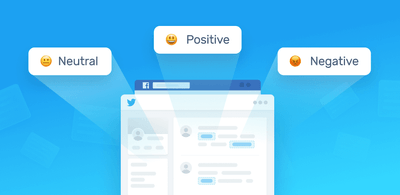Sentiment Classification – The Low-Down
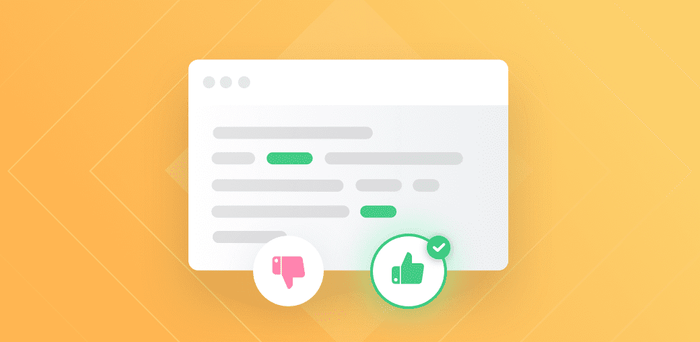
Sentiment classification is the automated process of identifying opinions in text and labeling them as positive, negative, or neutral, based on the emotions customers express within them. Using NLP to interpret subjective data, sentiment classification can help you understand how customers feel about your products, services, or brand.
Do you receive hundreds of daily mentions on Twitter? More emails to sort through than your team can handle? Perhaps you’ve just sent out an NPS survey and received a bunch of open-ended responses.
Reading and sorting all this data manually is time-consuming and tedious. And, what’s worse, while you’re busy sorting this data you’re probably missing out on other, or more important, conversations.
With sentiment classification tools, you can identify emotions in huge volumes of text in a matter of seconds. Not only delivering consistent and highly accurate results, but also managing data in real-time. Try out our free online sentiment classifier to see how it sorts your data.
Want to know more? Jump to one of the sections, below:
- Sentiment Classification Techniques
- Applications of Sentiment Classification
- How to Do Sentiment Analysis Using AI Tools
Sentiment Classification Techniques
It’s hard for machines to understand human language, and more so when identifying complex human experiences such as tone, attitudes, and emotion. Natural Language Processing (NLP) aims to solve this problem by using linguistics and computer science to transform text into something that computers can understand.
By applying a variety of NLP techniques ‒ like tokenization, lemmatization, dependency parsing, word sense disambiguation, and bag-of-words ‒ to analyze the syntactic and semantic aspects of a text, classifiers are able to process natural language data to understand emotions like anger, stress, happiness, and frustration.
While some NLP models are more emotionally intelligent than others, sentiment classification systems generally use one of three algorithms:
Rule-Based Systems
This approach applies a series of hand-crafted rules to establish a pattern for each tag. For sentiment classification problems, rule-based systems rely on a lexicon, which is a list of positive terms (like good, beautiful, useful, interesting, etc) and negative terms (such as bad, ugly, uncomfortable, frustrated, etc).
When fed a piece of text, the model counts the number of positive and negative words that appear, and assigns the corresponding sentiment. If a phrase contains more positive than negative words, it’s tagged as Positive.
However, this approach has some limitations. It can’t recognize words that don’t appear in the lexicon, and separates words from their context units making it difficult to identify polysemy, sarcasm, and irony.
For example, a phrase like “Excellent customer service? Far from it!” can be incorrectly tagged as Positive.
Finally, rule-based systems can be difficult to scale and improve, since adding new words to the lexicon might affect previous results.
Automated Systems (Based on Machine Learning)
Automated systems use machine learning algorithms that learn to predict sentiment from past observations. For this AI approach, you need an example dataset (similar to the data you’d like to analyze) along with their corresponding tags. This is called training data.
During the training process, the model transforms text data into vectors (an array of numbers with encoded information, basically, something that machines can understand) and identifies a pattern to associate each vector with one of the pre-defined tags (“Positive”, “Negative”, Neutral”).
After being fed a reasonable amount of relevant data, automated systems can start making their own predictions to classify unseen data. You can easily improve accuracy of these models by providing more tagged examples.
Hybrid Systems
Hybrid systems combine both rule-based and machine learning-based approaches. First, the model learns to detect sentiment from a series of tagged examples. Then, it compares the results with a lexicon to improve accuracy. The goal is to obtain the best possible outcome, with none of the limitations of each individual approach.
Applications of Sentiment Classification
Through sentiment classification, we can understand opinions on a large scale. This can have many applications for businesses, such as finding insights in customer feedback, keeping an eye on brand reputation, and spotting marketing trends and opportunities.
Customer Feedback
Sentiment classification can help you make sense of customer feedback, and allow you to get actionable insights from survey responses, product reviews, and customer support interactions.
What do customers love about your brand? What do they dislike? Are they happy with the way your customer service team handles their problems?
Analyzing sentiment in open-ended NPS responses can shed light on the reasons behind customers’ quantitative scores, as well as on specific aspects of your business that require more attention. If the main complaint among your detractors is that customer support teams are slow to respond, for example, you can try to automate part of your customer service.
After making changes to your customer support, you can send out another survey in the following quarter and compare results to see if brand perception towards your customer service has changed.
Social Media Monitoring
Companies use different metrics to monitor user engagement and keep track of social media mentions. But how can you know if customers are talking about you in a good or a negative way? Sentiment classification allows you to go beyond the numbers and learn how customers are talking about your brand, as well as boost customer loyalty and brand value by replying swiftly and effectively to every customer.
Analyzing sentiment across social media platforms can help you detect negative and urgent comments in real-time, so you can take action before they turn into a larger problem. Imagine you received a bunch of responses in a similar vein to this one, below. You’d want to detect them right away, and respond effectively and empathetically.

In this case, identifying a negative message in real-time allowed Asana to reply to their customer within seconds, showing them that they care about their feedback, solving their issues and – hopefully – winning back their loyalty.
Monitoring customers’ reactions on social media, after launching a marketing campaign or announcing a new feature, is also useful to understand how customers are receiving your campaign or feature. Are they expressing love towards your brand (promoters)? If so, you’ll want to ‘amplify’ their comments – maybe you’ll pinpoint influencers and send them freebies or promotions. Even sharing their messages can have a huge impact.
Monitoring reactions to competitors’ products or campaigns is also key. Are disgruntled customers frustrated about a particular aspect, or are they loving a new feature? Seize these opportunities, and swoop in with a better product.
Market Research
Following online conversations about a particular topic can also help you uncover trends and make decisions that make you stand out from your competition.
You might want to analyze sentiment in product reviews, and pinpoint what customers like and dislike. Maybe users find your competitors’ apps hard to use so, when it comes to marketing your tool, you can focus on how user-friendly your product is.
Some industries can be particularly affected by shifts in public opinion and, therefore, can benefit a lot from sentiment classification. Keeping track of “mood” in social media posts related to the cryptocurrency market, for example, can help predict if it's a good time to invest.
How to Do Sentiment Classification Using AI Tools
SaaS tools are a great way to get started with sentiment classification: they are easy to use (you don’t need machine learning expertise) and require little setup. Also, some of them provide integrations to connect with your favorite apps.
MonkeyLearn, for example, is a user-friendly machine learning platform, that offers two different alternatives to detect sentiment in text:
Use a Pre-Trained Model for Sentiment Classification
Pre-trained models allow you to get immediate results: you just need to paste your text into the classifier and click on “classify text” to obtain a prediction:
MonkeyLearn offers different pre-trained models for sentiment classification. You just need to register for free, go to the “Explore” tab and click on “Sentiment”:
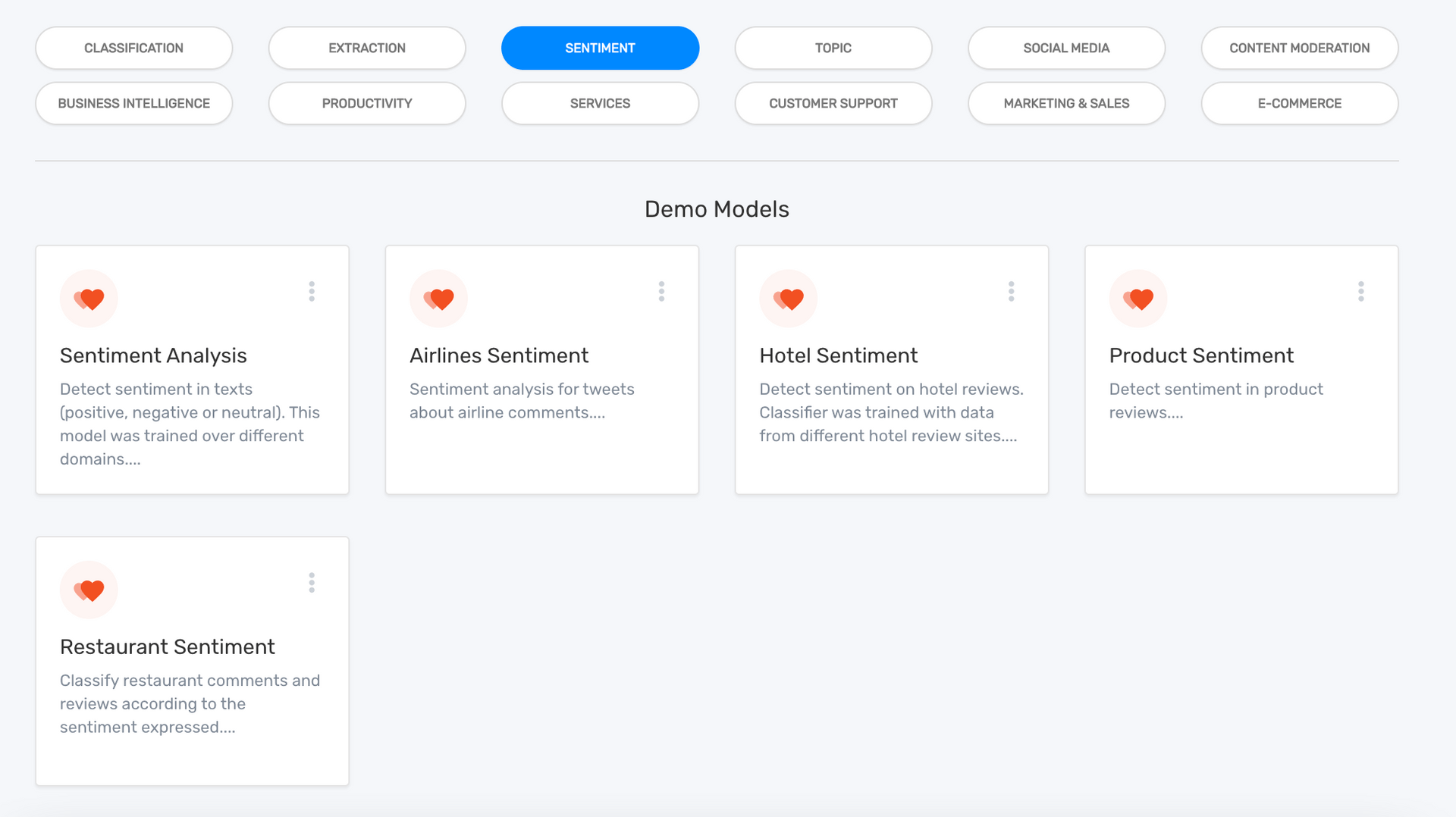
With pre-trained models, you can process data in a batch (by uploading an excel or CSV file) or even import data from third-party apps through one of the available integrations. Also, developers can use the pre-trained sentiment classification model via the MonkeyLearn API.
Building a Custom Model for Sentiment Classification
If you want to improve the accuracy of the results, or you’d like your model to recognize words and expressions that are specific to your domain, building a customized model is probably the best choice for you. And you can do it in just a few steps!
1. Choose a type of model. Go to the Dashboard, click on Create a model, and choose “Classifier”.
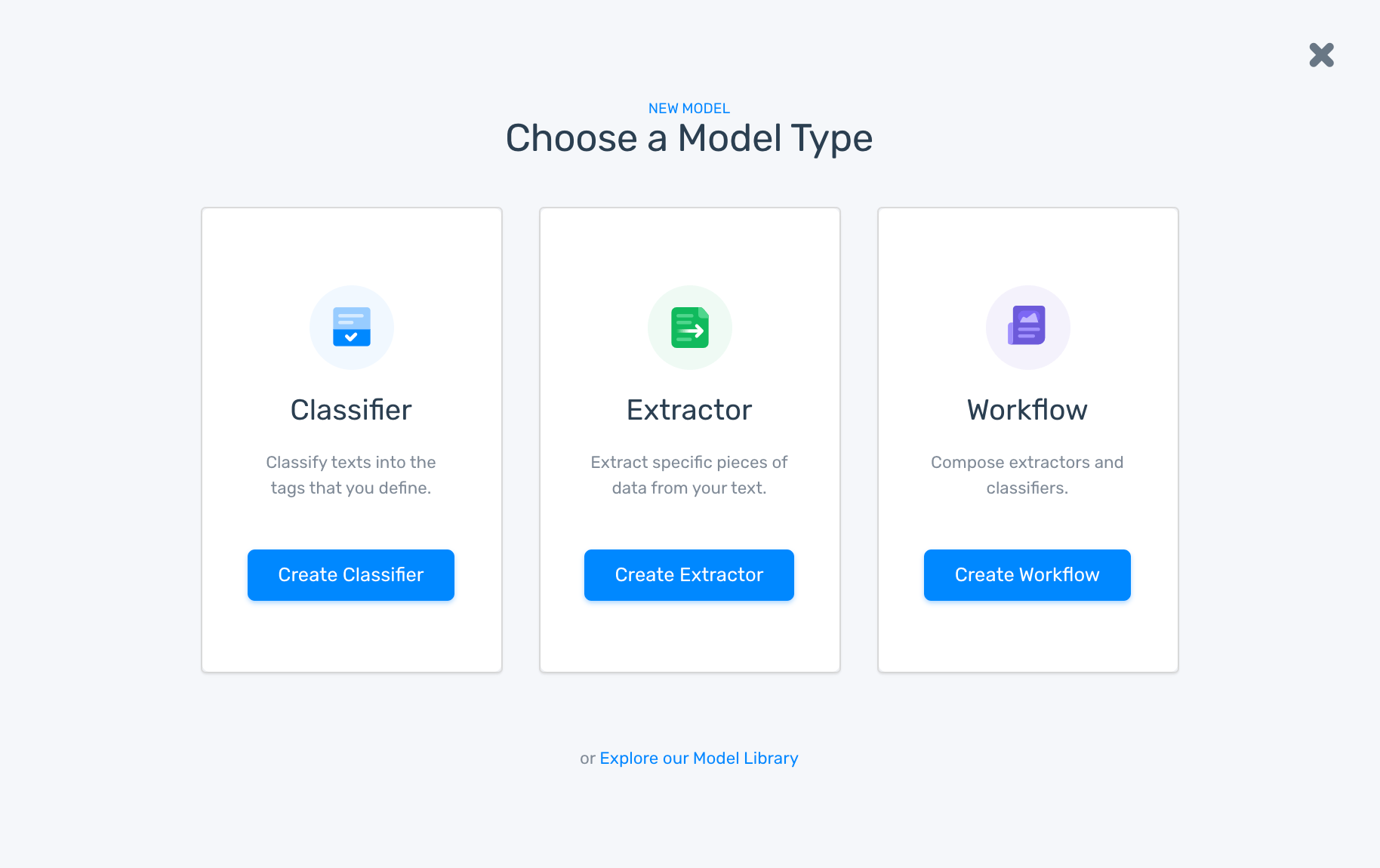
2. Choose a type of classifier. In this case, click on “Sentiment Classification”:
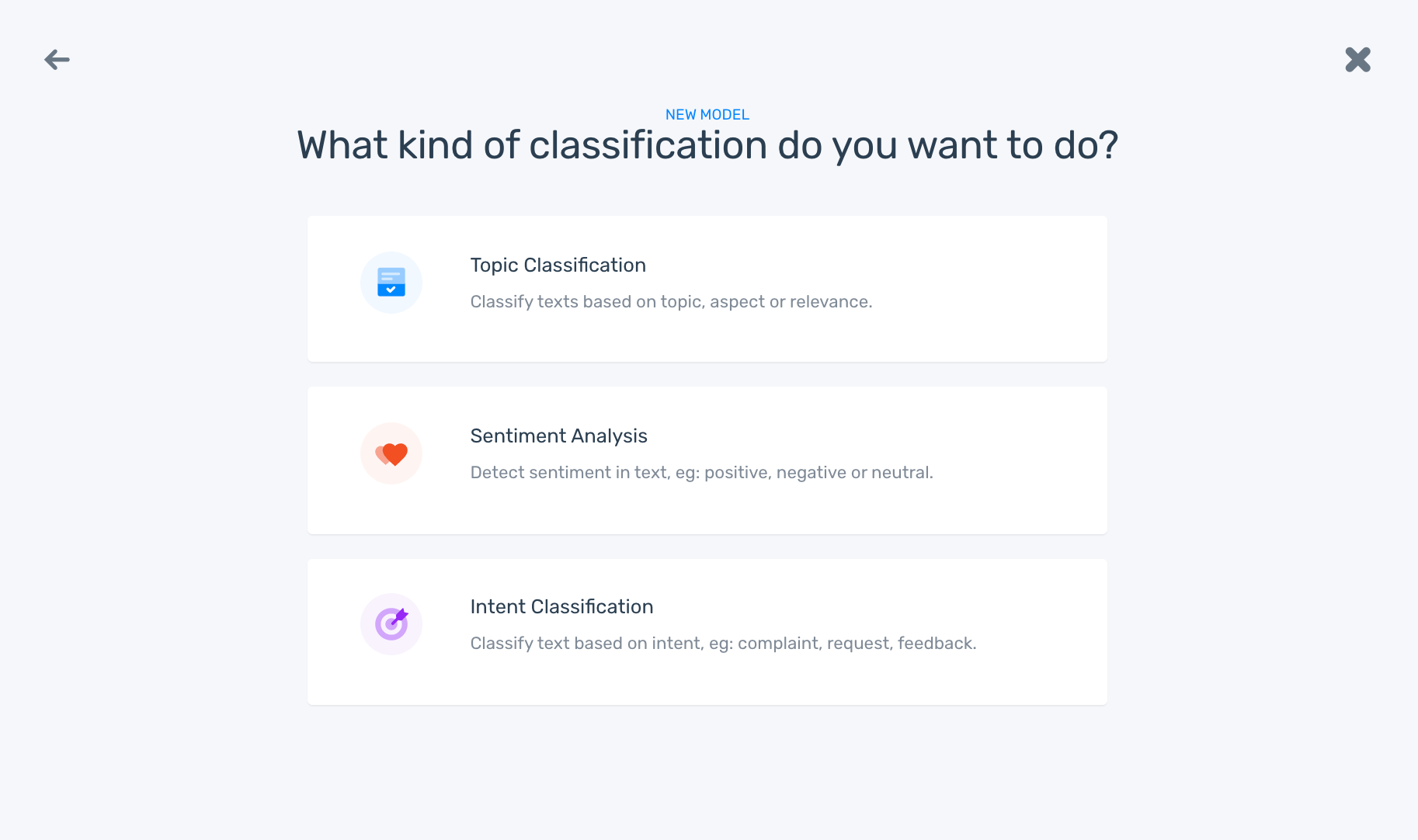
3. Import your data. Upload the text data that you will use to train the sentiment classification model. You can upload a CSV or an Excel file.

4. Train your model. Tag each piece of text as positive, negative, or neutral, according to your criteria.
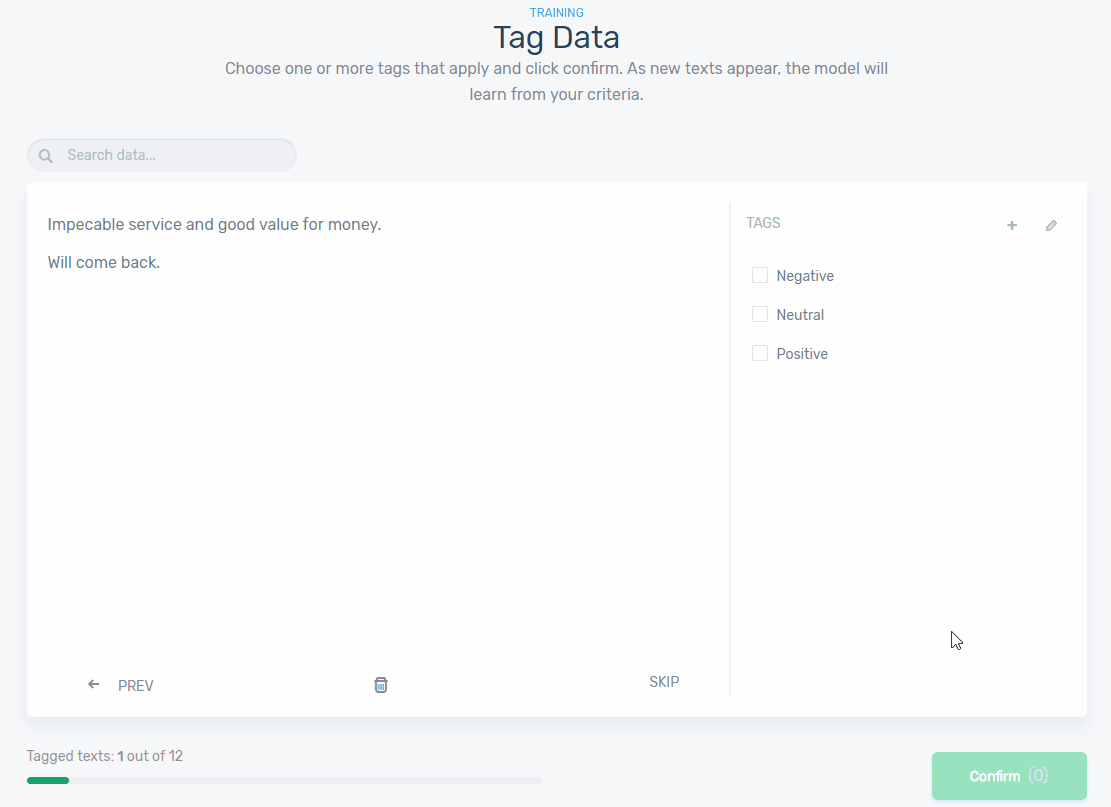
After you’ve tagged some examples, your model will start making its own predictions. You may notice that some results are inaccurate or have a low prediction score: re-tag them to improve your model’s performance.
5. Test your sentiment classifier. Click on the “Run” tab and paste some text to test your model. If it needs further training, go back to “Build” and manually tag a few more examples.

6. Put your model to work! You can now use your custom sentiment classifier to process data in a batch (upload an excel or CSV file), connect to one of the available integrations, or access through the MonkeyLearn API.
Final Note
Sentiment classification allows you to make sense of customers’ opinions. You can unlock the emotions hidden in social media posts, product reviews, and open-ended responses in online surveys, and discover valuable insights that will ultimately lead to better business decisions.
By analyzing sentiment on Twitter, you can spot negative comments in real-time, and take action before they escalate. Or, you can classify NPS responses to identify pain points expressed by detractors. Maybe you just want to route urgent inquiries more efficiently, or do some research into your competitors’ products. Sentiment classification tools can do all of this and more.
If you want to integrate sentiment classification into your business, there are many online sentiment analysis tools to make it as easy as possible. MonkeyLearn is one of the easiest and most powerful tools to help you get started with machine learning right away. Want to see how it works? Sign up for free to get started.

Tobias Geisler Mesevage
April 30th, 2020






